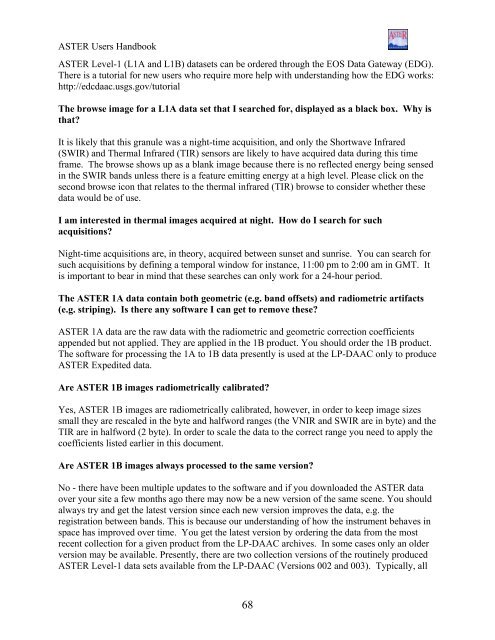You also want an ePaper? Increase the reach of your titles
YUMPU automatically turns print PDFs into web optimized ePapers that Google loves.
<strong>ASTER</strong> Users Handbook<strong>ASTER</strong> Level-1 (L1A and L1B) datasets can be ordered through the EOS Data Gateway (EDG).There is a tutorial for new users who require more help with understanding how the EDG works:http://edcdaac.usgs.gov/tutorialThe browse image for a L1A data set that I searched for, displayed as a black box. Why isthat?It is likely that this granule was a night-time acquisition, and only the Shortwave Infrared(SWIR) and Thermal Infrared (TIR) sensors are likely to have acquired data during this timeframe. The browse shows up as a blank image because there is no reflected energy being sensedin the SWIR bands unless there is a feature emitting energy at a high level. Please click on thesecond browse icon that relates to the thermal infrared (TIR) browse to consider whether thesedata would be of use.I am interested in thermal images acquired at night. How do I search for suchacquisitions?Night-time acquisitions are, in theory, acquired between sunset and sunrise. You can search forsuch acquisitions by defining a temporal window for instance, 11:00 pm to 2:00 am in GMT. Itis important to bear in mind that these searches can only work for a 24-hour period.The <strong>ASTER</strong> 1A data contain both geometric (e.g. band offsets) and radiometric artifacts(e.g. striping). Is there any software I can get to remove these?<strong>ASTER</strong> 1A data are the raw data with the radiometric and geometric correction coefficientsappended but not applied. They are applied in the 1B product. You should order the 1B product.The software for processing the 1A to 1B data presently is used at the LP-DAAC only to produce<strong>ASTER</strong> Expedited data.Are <strong>ASTER</strong> 1B images radiometrically calibrated?Yes, <strong>ASTER</strong> 1B images are radiometrically calibrated, however, in order to keep image sizessmall they are rescaled in the byte and halfword ranges (the VNIR and SWIR are in byte) and theTIR are in halfword (2 byte). In order to scale the data to the correct range you need to apply thecoefficients listed earlier in this document.Are <strong>ASTER</strong> 1B images always processed to the same version?No - there have been multiple updates to the software and if you downloaded the <strong>ASTER</strong> dataover your site a few months ago there may now be a new version of the same scene. You shouldalways try and get the latest version since each new version improves the data, e.g. theregistration between bands. This is because our understanding of how the instrument behaves inspace has improved over time. You get the latest version by ordering the data from the mostrecent collection for a given product from the LP-DAAC archives. In some cases only an olderversion may be available. Presently, there are two collection versions of the routinely produced<strong>ASTER</strong> Level-1 data sets available from the LP-DAAC (Versions 002 and 003). Typically, all68















